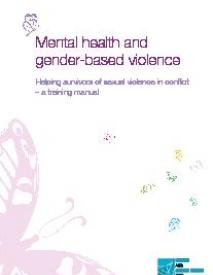Mental health and gender-based violence Helping survivors of sexual violence in conflict – a training manual
In recent years, several manuals and guidelines have been developed in the field of trauma. Some of these have addressed gender-based violence (GBV), its consequences, and ways to prevent it and protect against it. This manual focuses on the mental health of survivors of trauma, especially trauma associated with GBV. The aim is to provide a very practical supplement to the existing literature. The manual suggests approaches and techniques that address the psychological needs of GBV survivors, which helpers can use when they assist and provide care to individuals who are exposed to this form of violence. It focuses especially on ways of understanding how trauma affects the lives of survivors. The approaches presented will hopefully be of value in work with people exposed to other forms of trauma as well. It deals with such questions as: • What is the psychological meaning of trauma? • How do traumatic events affect mental health? • What are the signs of severe distress and how can they be assessed? • How can we create safe spaces that permit supportive dialogue and contact? • What approaches may assist a survivor to deal with trauma and move on in life? The manual is a resource for helpers working in emergency situations who have little or no access to specialised health services or to health professionals with psychological or psychiatric expertise. We hope it will assist helpers to identify and understand signs of distress, and deal more effectively with acute and sub-acute phases of trauma. Our intention is to provide tools and approaches that can stabilise survivors after they have been exposed to traumatising events, help them to deal with events that trigger traumatic memories, and teach them how to regain control of their lives. It also considers the stress that helpers themselves experience, the risk that they may suffer secondary trauma, and their need for support and communication. Additional training is available from other sources. HHRI has created a page about GBV on its website (www.hhri.org), where you will find relevant publications and guidelines as well as organisations and sites that work on this issue. Additional readings will be added on specific subjects and made available via links to the training material. The manual refers primarily to women and girls who are victims of sexual violence. Men and boys are also victims of rape, and sexual violence against males may often be especially difficult to talk about. We believe this manual is suitable for work with male survivors of gender-based violence, provided it is adapted appropriately. A separate training module would be required for working with children (boys and girls) who survive GBV. This training references documents on GBV against children and males, but it does not elaborate on their needs or address their situations explicitly.
Geachte bezoeker,
De informatie die u nu opvraagt, kan door psychotraumanet niet aan u worden getoond. Dit kan verschillende redenen hebben,
waarvan (bescherming van het) auteursrecht de meeste voorkomende is. Wanneer het mogelijk is om u door te verwijzen naar de bron
van deze informatie, dan ziet u hier onder een link naar die plek.
Als er geen link staat, kunt u contact opnemen met de bibliotheek,
die u verder op weg kan helpen.
Met vriendelijke groet,
Het psychotraumanet-team.
Reference:
2014
179 p | Health and Human Rights Info
http://www.joomag.com/magazine/mental-health-and-gender-based-violence-helping-survivors-of-sexual-violence-in-conflict-a-training-manual/0783880001404682542
ISBN 9788230326275
179 p | Health and Human Rights Info
http://www.joomag.com/magazine/mental-health-and-gender-based-violence-helping-survivors-of-sexual-violence-in-conflict-a-training-manual/0783880001404682542
ISBN 9788230326275


